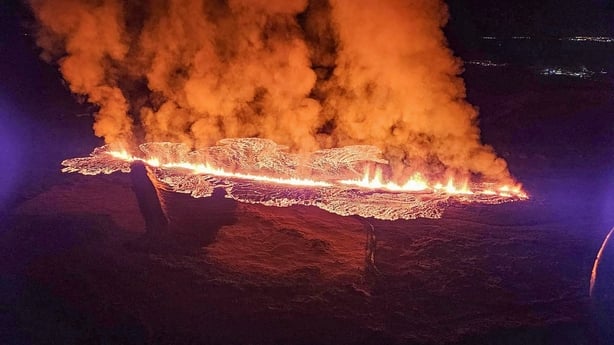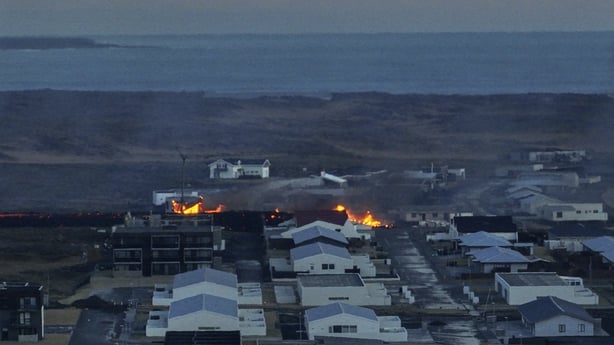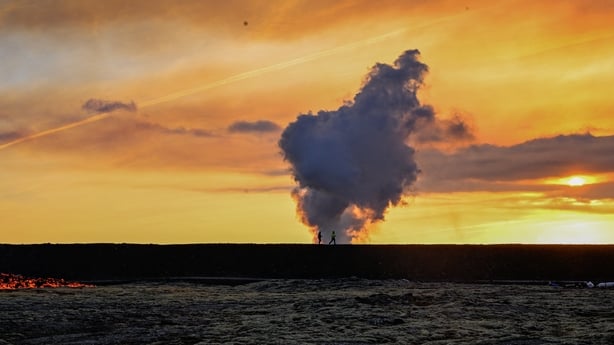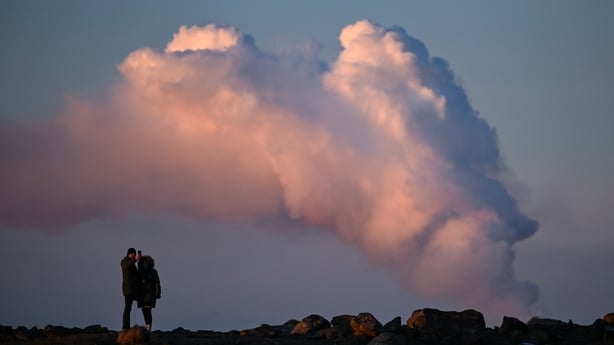The ongoing volcanic eruption in southwest Iceland has reached the port of Grindavik where two houses have caught on fire, according to surveillance footage broadcast by public television.
The few dozen residents who had returned to Grindavik after an earlier eruption were urgently evacuated overnight Saturday, hours before the latest eruption started.
Fountains of molten rock and smoke spewed from fissures in the ground across a wide area stretching to the town.
"No lives are in danger, although infrastructure may be under threat," Iceland's President Gudni Johannesson said on social media, adding there had been no interruptions to flights.

The eruption began early this morning north of the town, which just hours before had been evacuated for the second time since November over fears that an outbreak was imminent amid a swarm of seismic activity, authorities said.
Authorities built barriers of earth and rock in recent weeks to try to prevent lava from reaching Grindavik, some 40km southwest of the capital Reykjavik, but the latest eruption has penetrated the town's defences.
The nearby geothermal spa Blue Lagoon had closed, it said on its website.

It was the second volcanic eruption on the Reykjanes peninsula in southwest Iceland in less than one month and the fifth outbreak since 2021.
Last month, an eruption started in the Svartsengi volcanic system on 18 December following the complete evacuation a month earlier of Grindavik's 4,000 residents and the closing of the Blue Lagoon, a popular tourist spot.
More than 100 Grindavik residents had returned in recent weeks, before Saturday's renewed evacuation order, according to local authorities.

Workman fell through crack in ground
Late last night, authorities ordered an emergency evacuation to be completed by tomorrow due to growing seismic activity and its impact on the large cracks already present in the town.
On Wednesday, a 51-year-old Icelandic workman who was repairing a crack in a residential garden disappeared when the ground suddenly gave way beneath him.
He fell more than 30 metres. The intensive search to find him was called off on Friday because the area was too dangerous.
Authorities accelerated the evacuation order overnight when seismic activity intensified.

"What matters is where the lava flows. It is now very important to monitor it," IMO volcanologist Kristin Jonsdottir told RUV.
Officials are keeping a close eye on the area's Svartsengi geothermal plant, which provides electricity and water to the 30,000 residents of the Reykjanes peninsula.
Workmen have been building a wall to protect the facility since November.
Until March 2021, the Reykjanes peninsula had not experienced an eruption for eight centuries.

Fresh eruptions occurred in August 2022, and July and December 2023, leading volcanologists to say it was probably the start of a new era of activity in the region.
Four days after the 18 December eruption, authorities said volcanic activity had stopped, but they could not declare the eruption over because there was still a possibility of underground lava flow.
Iceland is home to 33 active volcano systems, the highest number in Europe.
Situated in the North Atlantic, it straddles the Mid-Atlantic Ridge, a crack in the ocean floor separating the Eurasian and North American tectonic plates.
